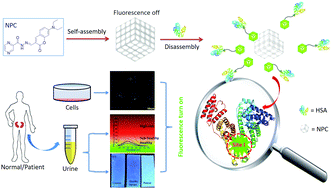A novel hydrazide Schiff base self-assembled nanoprobe for selective detection of human serum albumin and its applications in renal disease surveillance†
Abstract
Human serum albumin (HSA) is considered as a biomarker for the early diagnosis of renal disease, therefore identifying and detecting HSA in biological fluids (especially urine) with an easy method is of great importance. Herein, we report a novel hydrazide Schiff base fluorescent probe N′-((7-(diethylamino)-2-oxo-2H-chromen-3-yl)methylene)pyrazine-2-carbohydrazide (NPC), which self-assembled into nanoparticles in aqueous solution. Based on disassembly-induced emission and the site-specific recognition mechanism, the binding of NPC with HSA resulted in a fluorescence “turn-on” response. Probe NPC exhibited superior selectivity and sensitivity toward HSA with a detection limit of 0.59 mg L−1 in PBS and 0.56 mg L−1 in the urine sample. The site-binding mechanism of NPC with HSA was explored by fluorescence quenching study, Job's plot analysis, HSA destruction, site marker displacement and molecular docking. Fluorescence imaging of HSA in MCF-7 cells was achieved by using a non-toxic NPC probe, suggesting that NPC could be applied to visualize the level of HSA in vivo. More importantly, further practical applications of probe NPC in human urine samples were achieved with satisfactory results by using a fluorometer or test paper, which could provide extensive application in clinical diagnosis.



 Please wait while we load your content...
Please wait while we load your content...